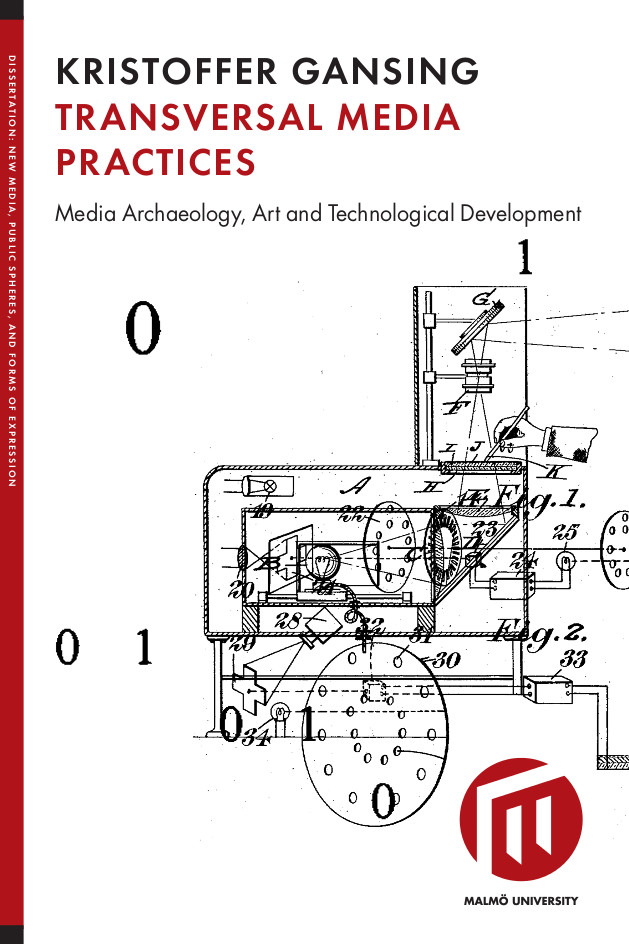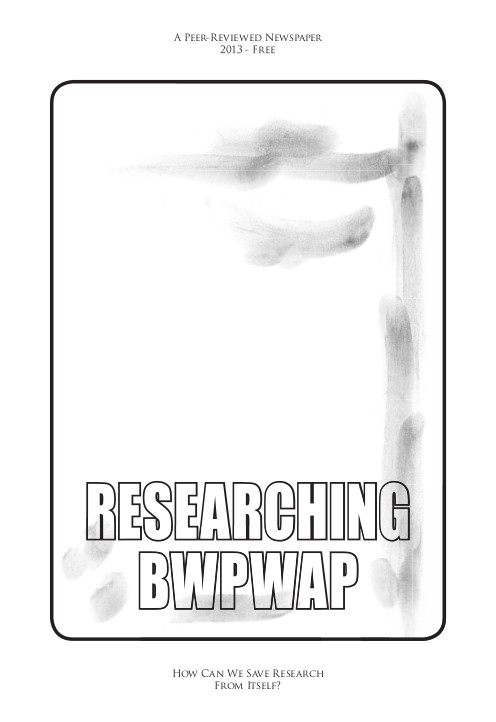Kristoffer Gansing: Transversal Media Practices: Media Archaeology, Art and Technological Development (2013)
Filed under thesis | Tags: · art, artistic research, imagination, media archeology, media art, new media, overhead projector, remediation, technology, television, transversality

Transversal Media Practices work across specific situations of technological development, critically examining and redefining the terms of production in different media by bringing heterogeneous histories, institutions, actors and materialities into play with one another. This dissertation is all about trying out and refining the methodologies of such transversal media practices, in the end outlining a conceptual set of tools for further development.
Following the technological hype of the “digital revolution” of the mid-1990s, the field of new media studies gained popularity over a ten year period. This dissertation takes its cue from a historical turn in new media theory, and argues that it is time leave behind strict polarisations between old and new as well as analogue and digital. The study unfolds through two case-studies. The first, “The World’s Last Television Studio”, looks at tv-tv, an art and media-activist project that negotiates the sociocultural and material changes of the “old” and institutionalised mass medium of television. In the second case study, “The Art of the Overhead”, another old medium is engaged: the overhead projector – a quintessential 20th century institutional medium here presented as a device for rethinking the new through the old. The problematic of technological development, i.e. dealing with questions of how (media) technologies develop over time, forms the background to these two case studies. A key issue being how cultural and artistic practices dealing with the interaction of old and new media invite us to conceptualise technological development in new ways.
The emerging field of media archaeology is employed as a methodology in media studies and cultural production, comprising a theoretical and applied analysis of media history, materiality and practice. This transversal approach allows media archaeologists to deal with the relation between the old and the new in a non-linear way as well as to pay attention to the technical materiality of media. It is argued that the transversality of the media-archaeological approach should be seen in contrast to other conceptions of media history and technological development, such as progressivist, mono-medial and evolutionary ones. In this study, the author tries out the potential of media archaeology to reform our conception of media technologies, and eventually formulates a set of concepts for thinking and doing media archaeology as a transversal media practice. These tools are about the imaginary, residual and renewable dimensions of media technologies and are meant to assist in the opening up and intervening into processes of standardised media development.
On a general level the resulting set of tools for transversal media practices builds a bridge between theory and practice: they can be used for further research and cultural analysis where objects of study speak back to analytical concepts. At the same time these are tools for transversality that expand this form of cultural analysis in that the travelling between disciplines here also means a travelling between theory and practice. On a specific level, the tools enable this travel between theory and practice in media- and communication studies, and as such they contribute to the development of new practice-based methodologies in media research.
Doctoral dissertation in Media and Communications Studies
School of Arts and Communication, K3; Faculty of Culture and Society; Malmö University
Dissertation series in New Media, Public Spheres and Forms of Expression
Creative Commons Attribution-NonCommercial 3.0 Unported License
ISBN 9789171044815
350 pages
publisher
public defense of dissertation (17 May 2013, Malmö)
Media archaeology at Monoskop wiki (incl. source bibliography)
PDF (updated on 2013-5-14)
Comments (3)A Peer-Reviewed Newspaper, 2(1): Researching BWPWAP (2013)
Filed under journal | Tags: · art, artistic research, code, design, economy, education, media art, net art, software

“In referring to the cancellation of Pluto’s planetary status in 2006, BWPWAP (Back When Pluto Was a Planet) – the 2013 edition of the transmediale festival – interrogates techno-cultural processes of displacement and invention, and asks for artistic and speculative responses to new cultural imaginaries. In light of this, the conference and workshop Researching BWPWAP took place in November 2012 in Lüneburg, Germany, organised jointly by Leuphana University of Lüneburg, Aarhus University and the reSource transmedial culture/transmediale. The call for participation focused on Ph.D. researchers and other participants to speculate on BWPWAP as a pretext for presenting their research and even to further reflect on its circulation as a meme.
This newspaper presents some outcomes of this process, and like the conference and workshop, can be interpreted in the context of a research culture that has been significantly destabilized by network culture and digital media. If the planet Pluto didn’t exactly fall prey to an epistemological break or a scientific revolution, but rather to a mundane administrative procedure – a redefinition of what constitutes a planet – then what does this say about contemporary research culture? Certainly, much research culture has shared Pluto’s fate: conferences reduced to networking events to foster cultural capital, and scholarly communications reduced to impact factors measured by grant givers. In other words, research is not just about measuring the performativity of a single researcher (the peer-reviewed journal system), but also the processes of questioning, investigating, speculating, and sharing between peers in a broader sense.” (from the Editorial)
Edited by Christian Ulrik Andersen and Geoff Cox
Publisher Digital Aesthetics Research Center, Aarhus University, Aarhus, in collaboration with reSource transmedial culture Berlin/transmediale, Berlin, February 2013
Creative Commons Attribution-NonCommercial-ShareAlike license
ISBN 8791810256
ISSN 2245-7593
PDF, PDF (updated on 2018-9-20)
Comment (0)Jess Wheelock (ed.): N52: On Art + Research at MIT (2011)
Filed under book | Tags: · art, artistic research, education, technology

A selection of conversations held by the 2010-11 alumni of the Program in Art, Culture and Technology with their colleagues at the Massachusetts Institute of Technology.
With contributions by Haseeb Ahmed, Gina Badger, Mary Ann Brooks, Deborah Douglas, John Hulsey. Jean-Baptiste Labrune, Catherine McMahon, Mabel Negrete, Dick Perdichizzi, Alise Upitis, Niko Vicario, Jess Wheelock, Sarah Witt, Ian Wojtowicz
118 pages
PDF (updated on 2012-8-14)
View online

